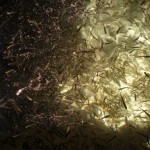- Using Footnotes to describe way-making , and add context
- Using Title HTML tags to define, and elaborate on concepts
- Signalling register and voice changes
- Signalling in-line edits with the combination of the strikethrough and italics keys
- Inserting revisions and updates with different font types
Note to audience/self: this addendum provides extra context for me, providing an anchor and history of the origins of the thought processes.
Key Concepts:
I am responding in part to rather long night of vivid lucid dreaming about the topic of defining the nature of academic blogging, brought on by a long stretch of active blogging the day and night before, and likely inspired as well by Walter Ong’s textbook, Orality and Literacy.
 In addition, I recently posted a photo of thousands of small fish in a holding pond, and it reminded me of the idea of piling 1
In addition, I recently posted a photo of thousands of small fish in a holding pond, and it reminded me of the idea of piling 1
But unlike piling, the blogging activities that involve layering, or adding layers of revisions and updates in various ways, can enable students to track their progress at different levels that go into more depth.
From reading Walter Ong’s chapter on how writing creates consciousness, I recognized that how we are taught to write is constrained by what we write with, the very technologies themselves. And how we do write in such a new medium such as blogging is tempered by how we are used to writing, and by the conventions we are expected to follow.
Currently, blogs are not so widely accepted as the equivalent as academic writing. It is so new in the history of writing, that standards of formal academic writing are maintained by peer review boards to ensure quality of presentation, to set very clear expectations for writers and readers of journals. Writing an academic paper about blogging, in my limited experience, is a frustrating experience.
(Move your mouse over the link to view the text) It is like asking the cat to be a dog.
How can blogging be demonstrated under the constraints of the writing conventions of a formal journal, when the very journal prevents the use of the texturing blogging makes possible? (Move your mouse over the link ‘texturing’ to view the overlying text)
So much of what blogging offers enables can be best demonstrated through the blogging tool, not other tools. Editing changes, such as the strikethrough, combined with the italicized text, can be used, as in this case, to shift ideas in mid-sentence, offering valuable insights for the students as they draft and revise their work. 2
The introduction of blogging into instruction is quite disruptive, requiring a discussion about what constitutes writing, and what should be done to develop skills in connective writing online in its various forms.
To date, blogging is simple, amounting to some use of links, photos, and a couple comments. In this post, I am demonstrating a number of techniques that can added to academic blogging so that it separates blogging from other earlier formats, creating a new genre with its own set of rules and conventions.
By combining footnotes, comments, and title tags, in addition to a number of techniques to signal changes of register and voice, to enhance student reflection on their own work over time, the original intent of these techniques are shifted from known standards of use, to a more fluid, flexible set of rules, where learners can be free to experiment and be creative.
The focus of blogging can be both the individual learner, to begin thinking beyond the two-dimensional writing space, and blog by being aware that one can add texture through layering and linking (third dimensional writing ) 3 as well as be aware that one can track and monitor and coordinate one’ own blogging efforts for emergent themes over time (fourth dimensional writing).
- I first came across this idea in Lilia Efimova’s blog, when she was referring to the classifying of posts using similar tags and adding posts to categories. ↩
- I have seen the use of the strikethrough repeatedly in other bloggers’ post, but have only used it myself for the first time in this post. ↩
- three-dimensional visualization of blogging activity and network-building has already begun, but is limited to date to the two-dimensional screen ↩

